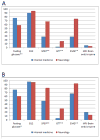The evaluation of distal symmetric polyneuropathy: a physician survey of clinical practice
- PMID: 22083798
- PMCID: PMC4254745
- DOI: 10.1001/archneurol.2011.1735
The evaluation of distal symmetric polyneuropathy: a physician survey of clinical practice
Abstract
Objective: To define current clinical practice for evaluating distal symmetric polyneuropathy.
Design: Using a modified Dillman method, we sent surveys to 600 internists, 600 neurologists, and 45 neuromuscular specialists selected from the American Medical Association Physician Masterfile. Survey questions pertained to which tests providers would order in the following 3 scenarios: (1) the initial evaluation of distal symmetric polyneuropathy, (2) the use of additional tests if the initial evaluation was unrevealing, and (3) patients with diabetes. The t test was used to compare the number of tests ordered by physician type, and the χ(2) test was used to compare proportions of tests ordered.
Setting: National survey of physicians.
Participants: Internists, neurologists, and neuromuscular specialists.
Results: The response rate was 35%. Overall, many tests were ordered for the full evaluation of distal symmetric polyneuropathy (mean [SD], 16.5 [7.2] tests), and there was substantial variation within and between provider types. Internists ordered fewer tests (mean [SD], 14.5 [6.1] tests) than did neurologists (mean [SD], 17.5 [7.9] tests) (P < .001). Regarding the glucose tolerance test, substantial differences were found between physician types, with neurologists and neuromuscular specialists ordering this test more frequently (28.6% and 72.3%, respectively) and internists ordering it less frequently (4.1%). A brain and/or spine magnetic resonance imaging scan was ordered by 19.8% of internists and 12.9% of neurologists.
Conclusions: From the supporting evidence, current practice intent on evaluating distal symmetric polyneuropathy is highly variable and differs widely. For this disorder of the peripheral nerves, a high-yield test such as the glucose tolerance test is rarely used, whereas magnetic resonance imaging is likely overused. Research that defines the optimal evaluation of distal symmetric polyneuropathy has the potential to result in more efficient care.
Conflict of interest statement
Author Disclosures:
Dr. Callaghan reports no disclosures.
Dr. Kerber received speaker honoraria from the American Academy of Neurology 2010 and 2011 annual meeting, and performed consulting work for the American Academy of Neurology. He is supported by NIH/NCRR #K23 RR024009 and AHRQ #R18 HS017690.
Ms. Smith reports no disclosures.
Dr. Fendrick serves as a consultant to the following: Abbott, ActiveHealth Management/Aetna, AstraZeneca, Avalere Health, BlueCross BlueShield Association, Blue Shield of California, Center for Medicare and Medicaid Services [CMS], GlaxoSmithKline, Health Alliance Plan, Hewitt Associates, Highmark BlueCross BlueShield, Integrated Benefits Institute, MedImpact HealthCare Systems Inc., Merck, and Co., National Business Coalition on Health, National Pharmaceutical Council, Perrigo, Pfizer Inc., Regence BlueCross BlueShield of Oregon, sanofi-aventis Pharmaceuticals, State of Indiana, Thomson Reuters, TriZetto, UCB, WebMD, zanzors. He is also on the Speaker’s Bureau for Merck and Co. He also is involved with research with the following: Abbott, AstraZeneca, Eli Lilly, Genentech, GlaxoSmithKline, Merck and Co., Novartis, Pfizer Inc., sanofi-aventis Pharmaceuticals.
Dr. Feldman reports no disclosures.
Figures


References
-
- Bharucha NE, Bharucha AE, Bharucha EP. Prevalence of peripheral neuropathy in the Parsi community of Bombay. Neurology. 1991 Aug;41(8):1315–1317. - PubMed
-
- Gregg EW, Sorlie P, Paulose-Ram R, et al. Prevalence of lower-extremity disease in the US adult population >=40 years of age with and without diabetes: 1999–2000 national health and nutrition examination survey. Diabetes Care. 2004 Jul;27(7):1591–1597. - PubMed
-
- Savettieri G, Rocca WA, Salemi G, et al. Prevalence of diabetic neuropathy with somatic symptoms: a door-to-door survey in two Sicilian municipalities. Sicilian Neuro-Epidemiologic Study (SNES) Group. Neurology. 1993 Jun;43(6):1115–1120. - PubMed
-
- Palumbo PJ, Elveback LR, Whisnant JP. Neurologic complications of diabetes mellitus: transient ischemic attack, stroke, and peripheral neuropathy. Adv Neurol. 1978;19:593–601. - PubMed
Publication types
MeSH terms
Grants and funding
LinkOut - more resources
Full Text Sources
Medical

